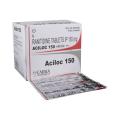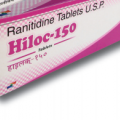Home / Categories / ORTAC-150MG

ORTAC-150MG
(10X10)
RANITIDINE-150MG
HISTAMINE 2 RECEPTOR BLOCKERS
ORION LABO, BANGLADESH
Product Details
Ranitidine
A to Z Drug Facts
Ranitidine
Action
Indications
Contraindications
Route/Dosage
Interactions
Lab Test Interferences
Adverse Reactions
PrecautionsPatient Care Considerations
Administration/Storage
Assessment/Interventions
Patient/Family Education
(ran-EYE-tih-DEEN)RanitidineZantac, Zantac 75, Alti-ranitidine HCl, Apo-Ranitidine, Nu-Ranit, Zantac-C, Novo-RanitidineClass: Histamine H2 antagonist
 Action Reversibly and competitively blocks histamine at H2 receptors, particularly those in gastric parietal cells, leading to inhibition of gastric acid secretion.
Action Reversibly and competitively blocks histamine at H2 receptors, particularly those in gastric parietal cells, leading to inhibition of gastric acid secretion.
 Indications Treatment and maintenance of duodenal ulcer; management of gastroesophageal reflux disease (GERD; including erosive or ulcerative disease); short-term treatment of benign gastric ulcer; treatment of pathologic hypersecretory conditions (Zollinger-Ellison). Unlabeled use(s): Prevention of upper GI bleeding; treatment of aspiration pneumonia; stress ulcer; and gastric NSAID damage. Used as a part of a multi-drug regimen to eradicate Helicobacter pylori in the treatment of peptic ulcer; protection against aspiration of acid during anesthesia; prevention of gastro duodenal mucosal damage that may be associated with long-term NSAIDS; to control acute upper GI bleeding; prevention of stress ulcers.
Indications Treatment and maintenance of duodenal ulcer; management of gastroesophageal reflux disease (GERD; including erosive or ulcerative disease); short-term treatment of benign gastric ulcer; treatment of pathologic hypersecretory conditions (Zollinger-Ellison). Unlabeled use(s): Prevention of upper GI bleeding; treatment of aspiration pneumonia; stress ulcer; and gastric NSAID damage. Used as a part of a multi-drug regimen to eradicate Helicobacter pylori in the treatment of peptic ulcer; protection against aspiration of acid during anesthesia; prevention of gastro duodenal mucosal damage that may be associated with long-term NSAIDS; to control acute upper GI bleeding; prevention of stress ulcers.
 Contraindications Hypersensitivity to ranitidine or other H2 antagonists.
Contraindications Hypersensitivity to ranitidine or other H2 antagonists.
 Route/Dosage
Route/Dosage
Duodenal Ulcer (Active)
ADULTS: PO 150 mg bid or 300 mg at bedtime. Maintenance: 150 mg at bedtime. IM/IV/Intermittent IV 50 mg q 6 to 8 hr.
Acute Benign Gastric Ulcer and GERD
ADULTS: PO 150 mg bid. IM/IV/Intermittent IV 50 mg q 6 to 8 hr.
Pathologic Hypersecretory Conditions
ADULTS: PO 150 mg bid. Individualize.
Erosive Esophagitis
ADULTS: PO 75–150 mg qid. IM/IV/Intermittent IV 50 mg q 6 to 8 hr. Continuous IV 6.25 mg/hr. For patients with Zollinger-Ellison, start infusion at rate of 1 mg/kg/hr and adjust upward in 0.5 mg/kg/hr increments according to gastric acid output (maximum 2.5 mg/kg/hr; infusion rate 220 mg/hr).
Renal Insufficiency (Creatinine Clearance < 50 ml/min)
ADULTS: PO 150 mg q 24 hr. IM/IV 50 mg q 18 to 24 hr.
 Interactions
Interactions
Diazepam: Pharmacologic effects may be decreased due to decreased GI absorption by ranitidine. Staggering administration times may avoid this reaction. Ethanol: May increase plasma ethanol levels. Glipizide: Possible increased hypoglycemia effect. Ketoconazole: May decrease effects of ketoconazole. Lidocaine: May cause increased lidocaine levels. Warfarin: Ranitidine may interfere with warfarin clearance. Hypoprothrombinemic effects may increase; may need adjustment.
 Lab Test Interferences False-positive test results for urine protein with Multistix may occur during ranitidine therapy; testing with sulfosalicyclic acid is recommended.
Lab Test Interferences False-positive test results for urine protein with Multistix may occur during ranitidine therapy; testing with sulfosalicyclic acid is recommended.
 Adverse Reactions
Adverse Reactions
CV: Cardiac arrhythmias; bradycardia. CNS: Headache; somnolence; fatigue; dizziness; hallucinations; depression; insomnia. DERM: Alopecia; rash; erythema multiforme. GI: Nausea; vomiting; abdominal discomfort; diarrhea; constipation; pancreatitis. HEMA: Agranulocytosis; autoimmune hemolytic or aplastic anemia; thrombocytopenia, granulocytopenia. HEPA: Cholestatic or hepatocellular effects. OTHER: Hypersensitivity reactions.
 Precautions
Precautions
Pregnancy: Category B. Lactation: Excreted in breast milk. Children: Safety and efficacy not established. Elderly patients: May have reduced renal function, therefore decreased drug clearance may be more common. Hepatic impairment: Use drug with caution; decreased clearance may occur. Hepatocellular injury: May occur, manifested as reversible hepatitis, hepatocellular or hepatocanalicular or mixed, with or without jaundice. Hypersensitivity: Rare cases of anaphylaxis have occurred as well as rare episodes of hypersensitivity. Rapid IV administration: May rarely result in bradycardia, tachycardia or premature ventricular beats, usually in patients predisposed to cardiac rhythm disturbances. Renal impairment: Decreased clearance may occur; dosage reduction may be needed. Hemodialysis reduces level of ranitidine-dosage timing must be adjusted so that scheduled dose coincides with end of hemodialysis.
PATIENT CARE CONSIDERATIONS
 Administration/Storage
Administration/Storage
-
Intravenous
- For IV use, medication is stable in 5% or 10% Dextrose Injection, 0.9% Sodium Chloride or Lactated Ringer's Solution.
- Administer without regard to meals.
- When administering via IV push, dilute to volume of 20 ml with Saline for Injection and inject over at least 5 min.
- For intermittent infusion, dilute 50 mg in 50 to 100 ml D5W and infuse over 15 to 20 min.
- Do not mix with other IV medications.
- Administer continuous infusion at rate of 6.25 mg/hr except for patients with Zollinger-Ellison syndrome.
- Store diluted IV solutions at room temperature. Discard after 48 hr.
-
Oral
- Do not give oral drug at same time as other antacids. Separate administration by at least 1 hr.
- Store syrup form in refrigerator.
- Dissolve EFFERdose tablets in 6 to 8 oz of water.
 Assessment/Interventions
Assessment/Interventions
- Obtain patient history, including drug history and any known allergies.
- Obtain baseline CBC, renal and liver function test results and monitor at regular intervals.
- Assess mental status before starting drug and monitor for changes.
- Notify physician if patient develops right upper quadrant abdominal pain, nausea, vomiting, change in color or consistency of stools, and jaundice.
- Slow rate of IV administration if bradycardia, tachycardia or premature ventricular contractions develop. If these conditions persist, stop infusion and notify physician.
- Notify physician if patient has arrhythmias, headache, fatigue, dizziness, hallucinations, depression, insomnia, alopecia, rash or erythema multiforme, or severe or persistent diarrhea.
OVERDOSAGE: SIGNS & SYMPTOMS Rapid respiration, respiratory failure, tachycardia, muscle tremors, vomiting, restlessness, pallor of mucous membranes, redness of mouth and ears, hypotension, collapse, lacrimation, salivation, diarrhea, miosis
 Patient/Family Education
Patient/Family Education
- Instruct patient not to take antacids at same time as drug. Separate administration by at least 1 hr.
- Advise patient to report these symptoms to physician: abdominal pain, nausea, vomiting, change in color or consistency of stools, black stools or coffee ground emesis; jaundice, headache, excessive fatigue, dizziness, unusual bruising or bleeding, petechiae, rash or shortness of breath.
- Discuss necessary dietary changes or restrictions appropriate for patient. Refer patient to dietitian if indicated.
- Advise patient with ulcers to avoid alcohol and smoking.
- Discuss stress reduction with patient if indicated.
- Instruct patient to dissolve effervescent formulation in 6 to 8 oz of water before drinking.
- Advise patient that drug may cause dizziness and to use caution while driving or performing other tasks requiring mental alertness.
Books@Ovid
Copyright © 2003 Facts and Comparisons
David S. Tatro
A to Z Drug Facts


